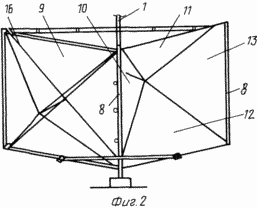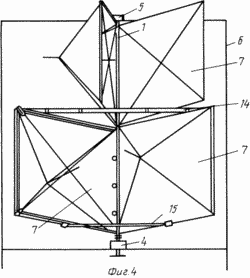| section Home Production, Amateur Radio amateur Model aircraft, rocket- Useful, entertaining | Stealth master Electronics Physics Technologies invention | space Mystery Earth Mysteries Secrets of the Ocean Stealth section Map | |
| Use of material is permitted for reference (for websites - hyperlinks) | |||
Navigation: => | Home / Products Patents / In the section of the catalog / back / |
|
INVENTION
Russian Federation Patent RU2248463
![]()
Pyramidal wind turbine
Name of the inventor: Stepanchuk Arkady Nikolaevich
The name of the patentee: Stepanchuk Arkady Nikolaevich
Address for correspondence: 85485, Donetsk region, Ukrainian, Str.. October, 2a, A.N.Stepanchuku
Starting date of the patent: 2003.03.20
The invention relates to wind energy and can be used to convert the natural energy of the air flow (wind) into mechanical and electrical energy. The technical result is a significant increase in the coefficient of performance (COP) of the engine. Wind turbine blades and contains the rotation axis is fixed on it, and the blades are made in the form of a system of three pyramids with the formation of the upper and lower tiers.
DESCRIPTION OF THE INVENTION
The invention relates to wind energy and is designed for converting energy of natural air flow (wind) into mechanical and electrical energy.
Unparalleled wind turbines with a rotor axis of rotation perpendicular to the wind direction (IPC F 03 D 3/00) can not compete on the unit capacity vetroelektroustanovok (wind turbines) wind turbines with a rotor axis of rotation which coincides with the direction of the wind (ie from propeller - IPC F 03 D 1/00), and therefore currently less prevalent (see. [1], p.76), for the following reasons.
Though they are driven by the winds in any direction and do not need systems orientation to the wind as the propeller, also do not need to arrange complex construction of the tower; it is not necessary to provide current collection mechanism, so as not to twist the cable; no need to build high towers, wind turbines authors of inventions with a vertical axis, to all appearances, are not good enough, as they invented design behave when working in air. And it was very important!
Thus, the wind turbine - similar [2] that is closest to my invention comprises a central vertical axis and fixed on her wings with a concave arch liners. The aim of the invention was to improve the efficiency of the engine. However, the full she could not be achieved for the reason that, first of all comprises four wings. My experiences have shown that already this moment (piling blades) enough to such an engine with any blade designs, due to the existing aerodynamic drag, did not work efficiently. Even if the average wind braking, parasitic effect observed firsthand.
Other wind turbine - analog [3], and is close to my invention. Here are three of the bar (which is optimal), but the three spherical cup mounted at their ends to form a gap between them, in which the wind penetrates and "beats" in the third blade, providing significant aerodynamic drag during operation of the wind turbine. This error has a distinctive all designs based on the "yokes": the shoulders are between the central axis and the axes of the blades, but also creates a "closure channel", which directs the wind and becomes useless parasite.
By analyzing both analog, it should be recognized that if they take the positive aspects: fixing the blades directly on the vertical axis, while there should be no more and no less than three, as in the second analogue, it turns wind turbine design, which is close to optimal.
But we must also take into account that each blade must be an effective catcher wind mechanical energy savers such maximum, get a move on easily, quickly gaining speed in the initial stage of promotion.
The invention aims at a significant increase in the coefficient of performance (COP) due to better capture and concentration of the air flow energy and reduce aerodynamic drag.
 |  |  |
 | Summary of the invention illustrated in more detail in Figures 1-4. 1 shows a general scheme for the wind power plant (TA), Figure 2 shows the blades on an axis in Figure 3 - a top view, and Figure 4 - a variant longline turbine performance. Depicted on the elements of the figures have a common digital numbering. Tubular axis wind turbine 1 in the joints 2 and 3 is supported on the bearing block 4 and an upper fixed bearing 5. The support 6, in turn, locks them in their nests itself not welded but bolted, thus ensuring its durability. a wind turbine rotor is formed from a vertical axis attached to one of three blades 7, set at an angle of 120 ° to each other (Figure 3) and formed as hollow four-sided pyramids. Every pyramid is fixed to the axis 1 having holes with bolts so that one side of the base 8 (Figure 2) adjacent each pyramid parallel and adjacent to said one axis, or so that the vertical axis portion is a common side of each pyramid. The height h of each pyramid and the side length of 8 are in the ratio 0.5: 1.0. More can not be done, because the protruding portion of each pyramid will overshadow the hollow interior of the adjacent pyramidal blades, and less to do is not desirable - reduced efficiency of wind turbines. | |
Between them the three pyramid-shaped blade from below and above must be held together by horizontal beams 14 and 15, and each blade is provided with a rope crosspiece 16 and passing through the center and top of the rod 17, which is convenient in the operation to put the scaffolding that provides blades maintenance (repair, painting etc.). Furthermore, the beams 14 are further supports 3-pyramidal blades of the upper tier. Therefore, the wind turbine can be a single-tier and two-tier (Figure 4). Layering can significantly improve the traction characteristics of the pyramidal wind motor for each of the six blades will have 60 °, and not 120 °, when in one tier. Since the common axis, the slightest breeze and the turbine has earned. However, such a two-tier structure of a wind turbine will require the maintenance of its system damping support vibrations or platform of the heavy wind. This system I invented, and is currently preparing an application for the invention to supply it to the Patent Office.
The inner hollow portion 9 of each pyramidal blades together with the adjacent side of the adjacent blades 10 form a device that catches the wind stream, it concentrates in the area to form an aerodynamic effect: a powerful head-push.
The speakers of the same (top 11, bottom 12 and the side 13) of each blade are very efficient reflectors, ie, dissect and optimally deflect wind turbulent flow away, providing a slight aerodynamic affect (resistance) while moving a wind turbine in it.
All this greatly increases its efficiency in comparison with the hitherto known to mankind wind turbines that convert wind energy into mechanical energy, makes pyramidal wind turbine (LDPE), their superior in all respects, ie puts it apart from the competition. For humanity, this is tantamount to reinventing the wheel!
In addition, LDPE - a high-speed turbines with high torque, therefore, it is not always necessary to apply a multiplier. The required shaft power generator or pump speed it can provide, greatly increasing the efficiency of wind turbines.
LDPE in the design concept is simple, compact, does not require high accuracy and can be used in the manufacture of any materials in two or three times more economical material costs compared with wind turbines close analogs and wind turbines in general.
Wind turbines with the PST can be installed on the ground, between floors, above the roof of the house (shop), or on a special tower (support), if only it was the following condition: it should always be "on the Seven Winds", where the air flow does not interfere with the terrain or artificial constructions. Hence, they serve, in most cases, much easier and cheaper.
Wind turbines with LDPE can be significantly operability compared to the closest analogues and wind turbines in general. For them will be no problem powering electric generators in more than 10 million kW. Whereas, according to media reports, of the existing wind turbines is the biggest acts in Germany. Its capacity of 2.5 ths. KW, rotor diameter and tower height of 80 m.
Currently, wind turbines designed to 3-5 ths. KWh by increasing the length of the propeller blades and the mounting height of the tower, but they will never take milestone in the development of 10 th. KW. Wind turbines is built on the basis of LDPE, will not only be able to take it, but also surpass it. Because they can not grow vertically and horizontally. Possible design solutions such wind farms with wind turbines in the JHA I can provide.
INFORMATION SOURCES
1. Article "big wind Time," "Electric stations" magazine. №1. 2003 Russia.
2. Description of the patent №2009371, cl. F 03 D 3/00, Russia.
3. A description of the patent №2067691, cl. F 03 D 3/00, Russia.
CLAIM
1. Wind motor comprising a rotation axis with blades fixed on it, characterized in that the blades are in the form of a three pyramids to form upper and lower tiers.
2. Wind motor according to claim 1, characterized in that each blade is positioned relative to the upper tiers of the lower tier of each blade at an angle of 60 °
print version
Publication date 02.02.2007gg






Comments
Commenting, keep in mind that the content and the tone of your messages can hurt the feelings of real people, show respect and tolerance to his interlocutors, even if you do not share their opinion, your behavior in terms of freedom of speech and anonymity offered by the Internet, is changing not only virtual, but real world. All comments are hidden from the index, spam control.